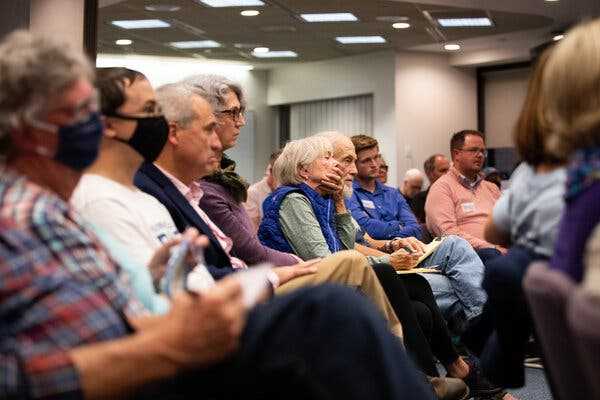With voters distracted by other issues and election denial flourishing, the country has what academics call a legitimacy problem.
-
Send any friend a story
As a subscriber, you have “>10 gift articles to give each month. Anyone can read what you share.
Give this articleGive this articleGive this article

A forum in Midland, Mich., for state legislative candidates. A New York Times reporter said that on a recent canvassing outing in the state, not a single voter brought up issues of democracy.
One way to read the striking results of the New York Times/Siena College poll released this week is that democracy is not shaping up to be the driver of votes that many on the left hoped it would be.
The obvious reason is that inflation is a far more immediate issue on the minds of most voters, who are watching their savings evaporate or struggling to pay their bills. That’s Abraham Maslow 101: Physiological needs of food and shelter will always take priority over abstractions.
But another way to interpret the survey is as yet more confirmation that American democracy is indeed in trouble.
In a Twitter Spaces conversation today with Ruth Igielnik, a staff editor for news surveys who worked on this week’s poll, and Nick Corasaniti, a national correspondent on the politics team, we unpacked why, even though 71 percent of voters agreed that democracy was at risk, only 7 percent said that democracy’s fragile state was the most important problem facing the country. You can listen to our discussion here.
Ruth noted that voters’ responses to the question “What one or two words do you think summarize the current threat to democracy?” were all over the map.
Some said “election deniers” or “Donald Trump,” while others said “Joe Biden,” “inflation and taxes” or “the one percent, a.k.a. Wall Street and hedge funds.” Another person said “our division” — that is, political polarization itself.
Nick, who recently returned from a reporting trip in Michigan, added some texture from tagging along during voter canvassing in Detroit and its suburbs, as well as in Saginaw, a city of about 50,000 people in the center of the state. Biden carried Saginaw County by just a few hundred votes in 2020.
“We encountered a ton of voters, and not a single one of them brought up any issues of democracy,” Nick said.
He added that the organizers, as they prepared the canvassers for what they should expect to encounter, told them: “You’re going to hear about issues like, why are our wages so low when we’re a predominantly union town? Why are prescription drug prices so persistently high? Why are there potholes in the road? Why can’t I get a garbage can?”
Lonna Atkeson, who studies political psychology at Florida State University, said voters were just thinking rationally. When it comes to protecting democracy, she noted, each side sees the other as the problem.
The State of the 2022 Midterm Elections
Both parties are making their final pitches ahead of the Nov. 8 election.
- Where the Election Stands: As Republicans appear to be gaining an edge with swing voters in the final weeks of the contest for control of Congress, here’s a look at the state of the races for the House and Senate.
- Biden’s Low Profile: President Biden’s decision not to attend big campaign rallies reflects a low approval rating that makes him unwelcome in some congressional districts and states.
- What Young Voters Think: Twelve Americans under 30, all living in swing states, told The Times about their political priorities, ranging from the highly personal to the universal.
- In Minnesota: The race for attorney general in the light-blue state offers a pure test of which issue is likely to be more politically decisive: abortion rights or crime.
“So there’s not really much to go on there other than to vote for your own party,” Atkeson said, “whereas the economy is a clear signal. It’s on your doorstep. You feel it every day. Maybe there’s something that can be done about that.”
A legitimacy problem
Most serious experts on democracy — academics who study governments around the world, and why they fall apart — would say that election deniers are the real danger.
And the new Times/Siena poll shows that millions of them are out there, despite zero evidence that the 2020 presidential election was stolen. As Nick wrote in an article explaining the poll results, “Twenty-eight percent of all voters, including 41 percent of Republicans, said they had little to no faith in the accuracy of this year’s midterm elections.”
There’s an academic term for that: a legitimacy problem.
Seymour Martin Lipset, a sociologist and political scientist who did seminal work on what makes democracies successful, published an influential paper in 1959 called “Some Social Requisites of Democracy: Economic Development and Political Legitimacy.”
At the time, he was trying to understand two main questions: why Europe veered toward extremist ideologies like fascism and communism after World War I, and whether the nascent democracies forged by fire and blood in World War II were sustainable.
Lipset defined democracy this way: “a political system which supplies regular constitutional opportunities for changing the governing officials.”
The United States still meets that pretty basic requirement. Despite Trump’s bellowing about a stolen election, and his efforts to whip up the mob that assaulted the Capitol, Biden duly assumed office in 2021 after a near-disastrous handover of power. The system held, albeit tenuously.
But Lipset’s framework should alarm us today because, as the Times poll suggests, nearly half the country still doesn’t consider Biden the legitimate president.
ImageMany of Donald Trump’s supporters deny the legitimacy of the last presidential election.Credit…Adriana Zehbrauskas for The New York Times
Pretend the U.S. is a foreign country; how would we explain what is happening? Two years on, the fever that powered an attempt to interrupt the peaceful transfer of power has not broken, and it’s still being stoked every day by the loser of the previous election.
As Lipset wrote, “If a political system is not characterized by a value system allowing the peaceful ‘play’ of power — the adherence by the ‘outs’ to decisions made by ‘ins’ and the recognition by ‘ins’ of the rights of the ‘outs’ — there can be no stable democracy.”
Lipset also defined a stable democracy as the absence “of a major political movement opposed to the democratic ‘rules of the game’” — which required, he thought, that “no totalitarian movement, either Fascist or Communist, received 20 percent of the vote.”
The one silver lining in the poll? Only 17 percent of the voters who saw democracy as threatened said there was a need to go “outside the law” to fix the problem. And of those voters, just 11 percent said the answer would be to “take up arms/violence/civil war.”
Then again, maybe that’s no silver lining at all: By my math, that would still be over a million people. Buckle up.
Image
What to read on democracy

By Neil Vigdor
-
A South Florida man became the first of 20 defendants ensnared in Gov. Ron DeSantis’s voter fraud dragnet to have charges dropped, ABC News reports.
-
The midterm legal battles have already begun: The Democratic National Committee has filed a court motion to try to stop Republicans in Pennsylvania who want to disqualify mail-in ballots without handwritten dates on them.
-
Tens of thousands of transgender people could be disenfranchised in the November elections because of strict voter ID laws and other rules in their states, according to Rolling Stone.
-
Nonwhite voters were 30 percent more likely to have their vote-by-mail application or ballot rejected compared with white voters in Texas, according to the Brennan Center for Justice, which analyzed data from the March primary.
-
Election offices large and small across the country are contending with internal threats that could undermine the integrity of the midterms: election deniers holding positions of power in them, CNN reports.
-
The head of a major federal union warned this week that demonization of the Internal Revenue Service by some Republicans could put the agency’s employees in danger.
-
Doug Mastriano, the Republican nominee for governor in Pennsylvania, is stepping up his courtship of right-wing fringe figures, including adherents of the QAnon conspiracy theory, The Philadelphia Inquirer reports.
Image
viewfinder
ImageSupporters of Stacey Abrams at a campaign event in Athens, Ga.Credit…Gabriela Bhaskar for The New York Times
On the trail in Georgia

By Gabriela Bhaskar
A couple of hundred people had gathered to wait for a glimpse of Stacey Abrams by the time her purple bus pulled up in College Square in Athens, Ga. Abrams’s supporters have often spoken to me about how inspiring it is for them to see her running for office when for so long Black women have organized politically behind the scenes.
I crept to the center of the crowd for a photo of Abrams as she spoke. At one point, I turned around and captured this image of a group of racially diverse and multigenerational women. To me, it represented a key group of her supporters and their feelings about her candidacy and the future.
Image
Thank you for reading On Politics, and for being a subscriber to The New York Times. — Blake
Read past editions of the newsletter here.
If you’re enjoying what you’re reading, please consider recommending it to others. They can sign up here. Browse all of our subscriber-only newsletters here.
Have feedback? Ideas for coverage? We’d love to hear from you. Email us at [email protected].
Image
Source: nytimes.com



